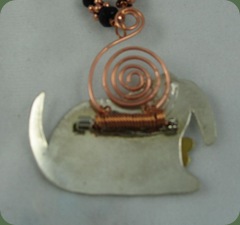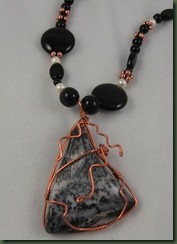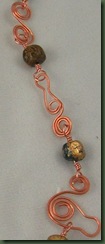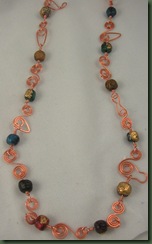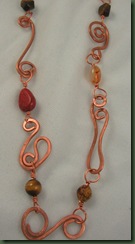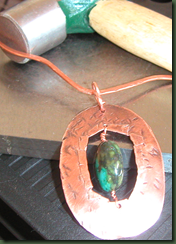Today is the posting date for pictures of designs completed in a Yahoo group to which I belong (Wire_Wrap_Texas@yahoogroups.com) About a month ago, those who participated in the group’s challenge received a small package of beads with which we were to complete a project. Basically the only stipulation was to use most of the beads and include some wire work. The package contained a few glass beads, rounds, copper spacers, a small black donut and a large crystal nugget. The latter two didn’t seem to fit with the others and the challenge began! Being majorly compulsive, I wanted to dive right in when the beads arrived, but made myself leave them alone. I lay them out in a saucer on my desk and peered at them for a week or so while repeating, “incubation is a good thing.”
Part of my goal with the challenge was to combine multiple elements of metal and wire with more delicate seed bead work. At first, I envisioned a netting of tiny seed beads covering the crystal nugget and providing some color. While this worked well, and I now know how to do this, the crystal still didn’t fit with the other beads. I added a pewter butterfly and some ribbon and gradually, things grew worse!  Laying it aside, I picked up that black donut. “Now what?” I wound ribbon around it, wrapped this with 24 gauge copper wire and finally embellished it with a bit of seed bead embroidery. I also created several different sizes of wrapped rings to go with this one and hung the ugly crystal inside the largest circle. Using wire links to put the necklace together it looked great in my mind but pretty yucky in real life. Would I post a picture of this one challenge day? Definitely not!
Laying it aside, I picked up that black donut. “Now what?” I wound ribbon around it, wrapped this with 24 gauge copper wire and finally embellished it with a bit of seed bead embroidery. I also created several different sizes of wrapped rings to go with this one and hung the ugly crystal inside the largest circle. Using wire links to put the necklace together it looked great in my mind but pretty yucky in real life. Would I post a picture of this one challenge day? Definitely not!
Finally, feeling that I had been challenged enough, I designed a moon shaped copper piece cut from sheet metal and hung dangles from the holes I drilled. The seed bead embellished donut now hangs from the center of the piece and the crystal nugget? Oh dear, . . . I must have lost it somewhere! 
Did I learn anything from this challenge? You bet!
· I learned that my skills do not always enable me to make what I see in my mind.
· I have again confirmed that too much embellishment, as in the case of the crystal nugget, can ruin a piece.
· I learned how to cover beads with netting and how to change the look of a form with ribbon and wire to create a unique pendant or link for a strand.
· I realized that incubation and resistance to closure is still hard for me even though I continue trying to improve.
· I am reminded that there is a certain level of frustration in a challenging situation that is good and propels us, while too much frustration inhibits progress. It’s a delicate balance and the physical and emotional place we are in at the time of the challenge greatly affects the rigor we can handle. I believe that we each have to learn what level helps us grow and branch new dendrites.
· Lastly, I learned that I like having friends who support my learning.


